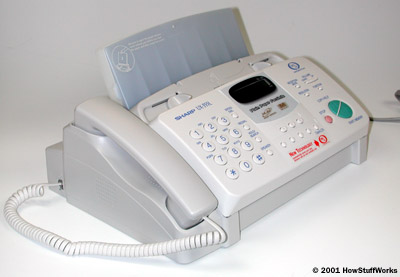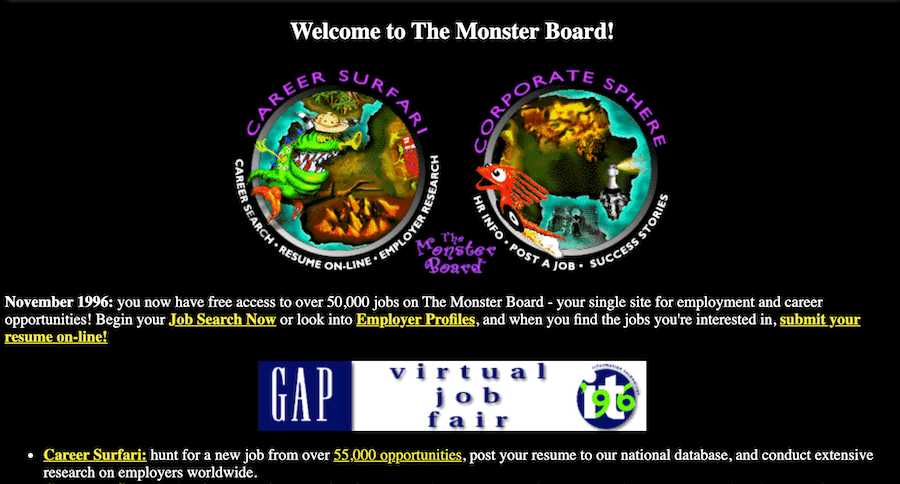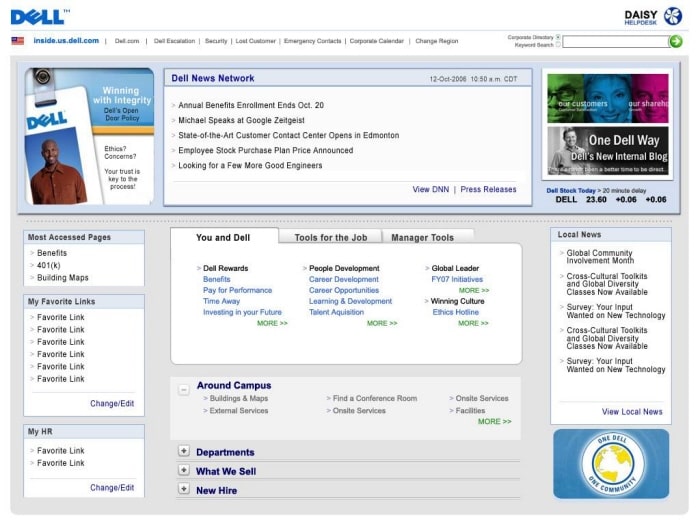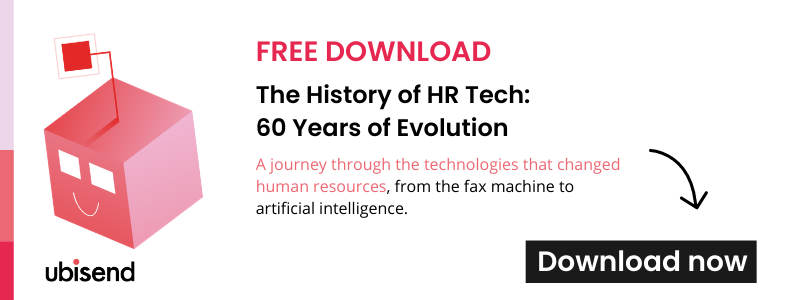The History of Technology in Human Resources

Over the last few decades, technology has greatly influenced the practices of human resources departments. Each development has fundamentally changed aspects of HR functions across all industries for the better.
Today, the use of technology runs deep through most businesses, especially their HR departments and how they communicate with employees.
In this article, we take a long trip down memory lane and explore the evolution of HR tech; from the very first fax machine to the latest HR chatbots.
Editor's note: by popular demand, we've turned this piece of content into a downloadable (and pretty) PDF. Grab it for free: The History of HR Tech: 60 Years of Evolution.
The history of HR tech
Pre-1990s – Fax machines, papers, and the first HRMS
Human resources from its inception until the 1970s was primarily paper based. There were no enterprise resource planning (ERP) systems or employee databases to store information, and no way of automatically sharing information. To send documents up until this time you only had one option: manually delivering it, either by courier or through the postal service.
Unsurprisingly, this was a slow process. To save time, companies often sent the original document, compounding the time cost with the risk of losing the document along the way. At the very least, there wouldn’t be any time to edit or review documents once they’d been sent, and the recipient wouldn’t be able to react for days at a time.
Although fax machines had existed for decades, it wasn’t until 1980 that they went mainstream, with the introduction of an international standard allowing for their success (source). After all, you can’t send a fax to someone without both of you having access to a machine.
For those of you who don't remember (which might be most of you), this is what a fax machine used to look like:

Courtesy of howstuffworks.com
It may now seem outdated but sending a facsimile from one machine to another was a huge advancement at the time.
Being able to send contracts to a director based in another office, for example, now took a fraction of the time it would have previously. HR departments could now also keep hold of the original documents, ensuring their safety and improving organisation by keeping all documents in one location.
A key development in the world of ERP, 1987 saw the introduction of PeopleSoft as the first-ever purpose-built HR management system (source). Though it was quickly superseded in the early 1990s by several competitors covering all HR functionalities, the base functions of an average HR department were now fully covered by technology and there was no looking back.
Some key dates before the 1990s
- 1964 – Xerox Corporation introduces LDX (Long Distance Xerography), widely considered the first modern commercial fax machine.
- 1971 – Electronic mail is invented by Ray Tomlinson
- 1980 – An international standard for fax machines is established in Japan, prompting their widespread adoption.
- 1987 – PeopleSoft, a purpose-built HR management system is released.
1990s – The World Wide Web scales the ERP systems
Think about how useful the internet feels today.
Now place yourself in the shoes of someone experiencing it for the first time in the early 1990s.
This wonderful network allowed computers all over the world to interact with each other, paving the way for globalisation and the digital landscape we know today. Emails were no longer restricted to internal networks and websites could shout your message to the entire world.
In HR, websites changed the landscape of recruitment by expanding the available talent pool. Recruiters were no longer restricted to selecting from a narrow pool of applicants made aware of the role in the local newspaper. Instead, they could advertise a role to anyone with an internet connection, hoping to attract the most qualified candidates no matter where they were.
Monster launched the first-ever online recruitment website in 1994. Now, careful, this will hurt your eyes (and brain). Here's what monster.com looked like in 1996, courtesy of web.archive.org:

Today, monster.com receives 29 new CVs and almost 8,000 jobs searched by applicants every single minute (source). No HR department or recruitment agency in the world would be able to process that many applicants without the use of technology; even the possibility of such a workload would be unimaginable 30 years ago.
Though many other online recruitment tools have since surfaced, such as LinkedIn allowing to direct communication with prospective candidates, online job listings remain a significant source for recruitment at both agency and company level.
In 2018, 85% of job applications were made via job boards or career sites (source). While this longevity certainly goes hand-in-hand with the wider digitalisation of society, it would have been difficult to predict when trendsetters such as Monster were first exploring this technology.
The burgeoning online world allowed
HR’s ERP systems to become part of non-HR employees’ lives, giving rise to the
introduction of employee self-service platforms.
Technology was starting to pull everything into a digital environment, one which could be accessed with ease no matter where you were. Can you believe that just 25 years earlier everything was still so basic?
Some key dates
- 1991 – The world wide web is released to the general public.
- 1993 – The Mosaic web browser is developed by the National Center for Supercomputing Applications, allowing images to be displayed alongside text for the first time.
- 1994 – Monster established the first-ever online job searching database.
- 1996 – Frontier Technologies release Intranet Genie, a bundle of applications for creating intranets.
- 1998 – Applicant Tracking Systems (ATS) allow pre-determined criteria to be filtered.
- 1999 – The internet has 400 million users worldwide.
2000s – Intranets power up and boost internal communications
While the internet is a great way to interact with external stakeholders, in the early 2000s it wasn't really used for internal communications (except via email, of course). For internal comms, the intranet was born.
An intranet mimicked the internet while limiting access to those within a specific organisation. This allowed more focused (and sometimes sensitive) information to be shared, such as company news, internal structural changes, and announcing employee departures.
The more astute amongst you will recall that intranets had existed since before the internet. Indeed, they had.
But the invention of the internet in the 1990s gave the old and dusty intranet a massive boost, making them more useful. The world wide web meant that intranets could now be accessed remotely, for example, extending their reach outside of the office's physical location.
Early adopters, primarily large multinational corporations, such as Pfizer, Dell, and Hewlett-Packard (source) trail blazed use of this technology in the late 1990s, and still reap the benefits of early adoption today.
Here's a look at Dell's 2007 intranet, courtesy of Leeann Baker.

Use of an intranet goes further than the simplistic communication of emails, allowing for a more visual presentation. They also serve as fantastic hubs for company information, allowing for the storage of useful documents which can be freely downloaded by employees when needed. Employees could also be identified and organised with individual accounts containing their personal information, a useful tool for HR departments responsible for large businesses.
Cisco Systems, an American technology conglomerate, have frequently received recognition for their intranet throughout the 21st century, including several awards from the Nielsen Norman Group for its employee support and design (source).
Intranet expert Toby Ward believes that Cisco’s intranet benefitted from five key pillars which presented employees with a means of staying informed:
- Video – Visual-audio presentations available in real-time, allowing key personalities within the company to spread their message.
- Mobile – Secure access to company information and people through any device, anywhere.
- Social – Proactive interaction between employees allowing expertise to spread within the company.
- Apps – Simple access to internal systems.
- Content – Millions of pages of company information; an entire knowledge base available to employees at any level.
(Source)
Intranets provide a vital human element of social interaction the workplace, allowing HR departments to better connect with other employees, and vice versa.
Toby Ward's list clearly sets a path of expectations for future technologies. Employees want interactions, speed, content at their fingertips, visual elements. Unsurprisingly, we find all of these attributes in today's HR chatbots. Without the development of the intranet technology throughout the 2000s, today's technologies (including chatbots) wouldn’t have been nearly as successful…
Some key dates
- 2000 – 15% of organisation have adopted employee self-service HR technology. Early adopters include Pfizer, Dell, and Hewlett-Packard.
- 2003 – LinkedIn is founded, becoming the first professional social media site.
- 2005 – 50% of organisations have adopted employee self-service HR technology.
2010s – HR portals, live chat, and first steps towards chatbots
Though intranets still serve a purpose in many businesses today, many of their HR applications gave way to dedicated HR portals in the 2010s. A well-designed intranet might help to broadcast information to employees but what about messages from employees to the HR department?
The first attempts at solving this challenges came in the form of an HR live chat. Through a purpose-built HR system, the live chat allows communication to go both ways, and only when needed.
This approach also takes the first step towards providing more specific information to employees based on their role. This system would allow employees to find out how much holiday they had left to take, for example, information which would previously have only been available through direct contact with the HR team.
An HR portal would not only be able to tell employees this information, it also gives them the tools to act on this themselves (i.e. booking holiday through the portal). Giving employees access to this tool frees up the HR team to focus on more important tasks. Employees would be able to direct their own onboarding process, for example, ensuring that new hires have all the tools they need to feel comfortable in their new role. This can include a guide on how to interact with management, as well as standard practices within the organisation.
It can also give both employees and managers valuable insight into their own performance levels through the application of feedback and review functions. Think of this as giving your non-HR employees the insider knowledge they need to succeed and boost the effectiveness of your business with no additional legwork required from HR!
Learning and development is another HR function which can be greatly optimised by giving employees updated methods of requesting training. These requests could get lost in a sea of emails if sent to a manager or a member of HR, who are both often responsible for many different people. By automating the process and giving complete control of their own development needs to each employee, progress can be made much quicker and provide a detailed history of employee growth.
Purpose-built HR portal allows for another significant technological development of the 2010s to make their way into the business world: instant messaging.
Originally introduced as a means of communication in our personal lives, instant messaging overtook texting as the #1 communication method in 2013, with the gap only expected to widen over time (source).

Incorporating such a popular platform into a professional environment seems straight-forward; employees already know how it works and the immediacy of response means that conversations advance more quickly than via email.
Giving employees the ability to communicate with their HR team via chat allows HR reps to respond to enquiries quicker and more effectively. Their focus can remain on another task until the chat bubble notifies them of a message, unlike a phone call which requires their undivided attention for the duration of that enquiry.
This is a turning point in the HR industry. Instant messaging and live chat bring a wind of change to the department, and create a stepping stone towards more automation -- particularly chatbots.
Some key dates
- 2015 – 90% of organisations have adopted employee self-service HR technology.
- 2019 – 92% of HR leaders believe the future of providing excellent employee service has to include chatbots.
2020s – Chatbots go mainstream
It's the next logical step.
While live chat improves the HR reps' efficiency, a few limitations remain. The number of enquiries each rep can handle, the speed at which they can type, the time it takes to process enquiries, locate information, and send responses -- all of these are finite.
Thankfully, the tail-end of the 2010s brought us technology that can help circumvent these limitations. The advances in artificial intelligence and emergence of chatbots allows the implementation of machines that can respond to enquiries much faster and on a much greater scale than any human.
Conversational AI software, or chatbots, retains the features of human conversation. They are, by design, conversational.
Using natural language processing, chatbots break messages down and decipher the information it needs to find in order to best respond. It then zips through your knowledge base to extract and provide that information. All of this takes place in a fraction of the time it would take manually, saving time for the employee enquiring and the human HR rep it would previously have required.
A single chatbot can even take part in hundreds of conversations at once, with no extra time or energy needed to do so!

One of our clients implemented a chatbot to help their HR department serve over 100,000 employees spanning across 75 countries. Their HR department struggled to meet demands with around 100 new enquiries landing in their inbox every week -- the team simply didn’t have the coverage to respond quickly enough.
The first iteration of their solution, an all-knowing HR chatbot, helped decrease in inbound email enquiries by 43%.
You can read more about this case study here: FTSE100 HR Chatbot Decreases Inbox Traffic by 43%.
Every new piece of HR technology over the last 40 years has brought a wind of change; a change for the better, faster, stronger. There was a time when companies functioned without an ATS or ERP. Today, not leveraging these platforms seems unfathomable. What may have seemed like a nice-to-have in the 1990s is now a must-have.
The same holds true for chatbots. Throughout the 2010s, the technology has evolved and taken a pivotal role within organisations worldwide. Businesses are investing in chatbots and virtual assistants now to avoid playing catch-up when another decade has gone by.
Conclusion
Technology has developed at a rapid pace over the last few decades. Businesses that adopt new technologies early often reap the long term benefits.
Remaining on the cusp of new technology is primordial to maintaining an edge over your competitors. If they beat you to the punch it could seem like you’re just playing catch-up when you implement the same technology at a later date. It pays to stay on top of things, solidify your organisation’s reputation as an industry leader and reap the rewards when they’re at their greatest.
Learn more about chatbots in HR.













